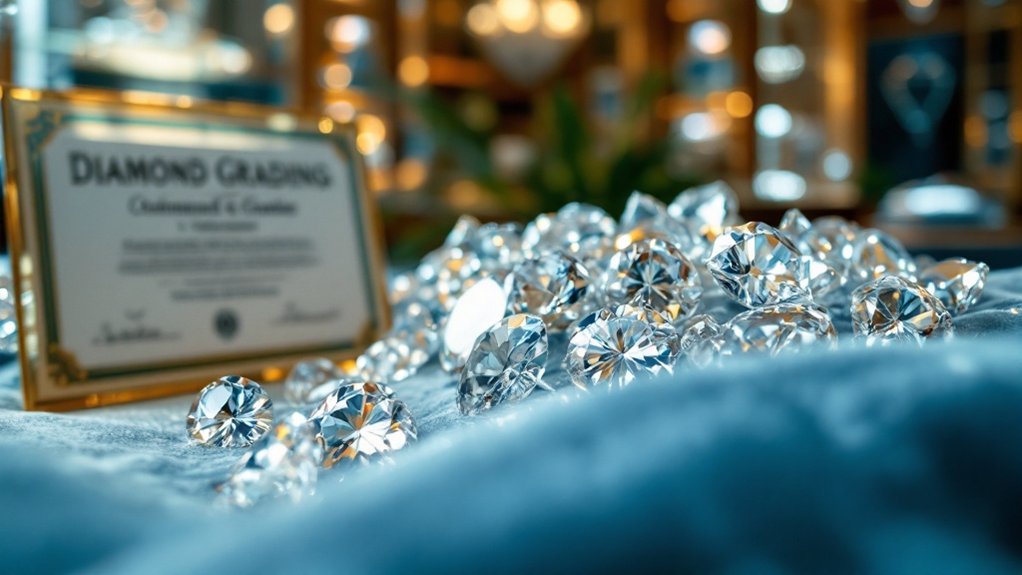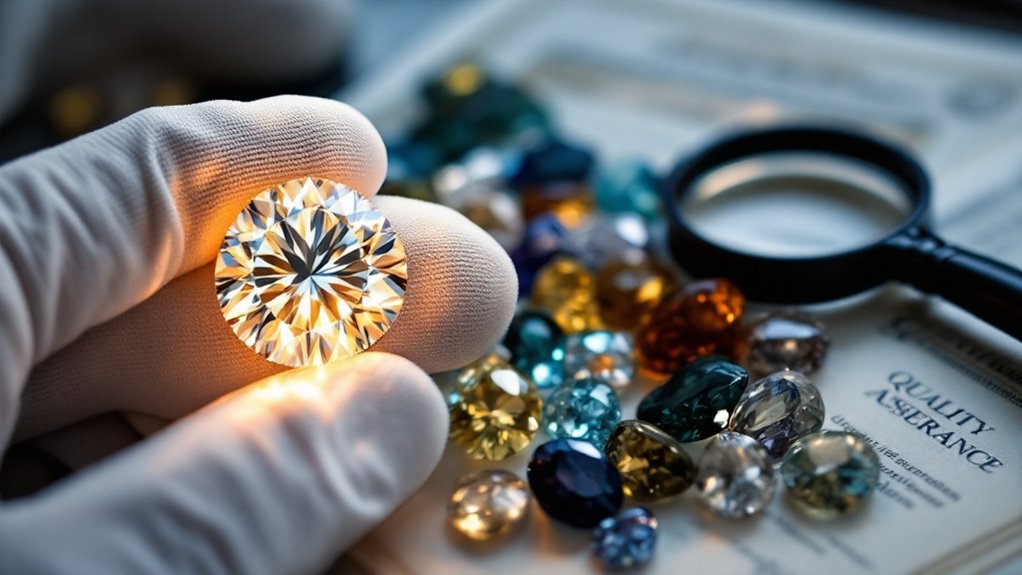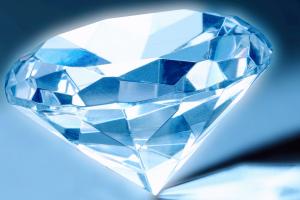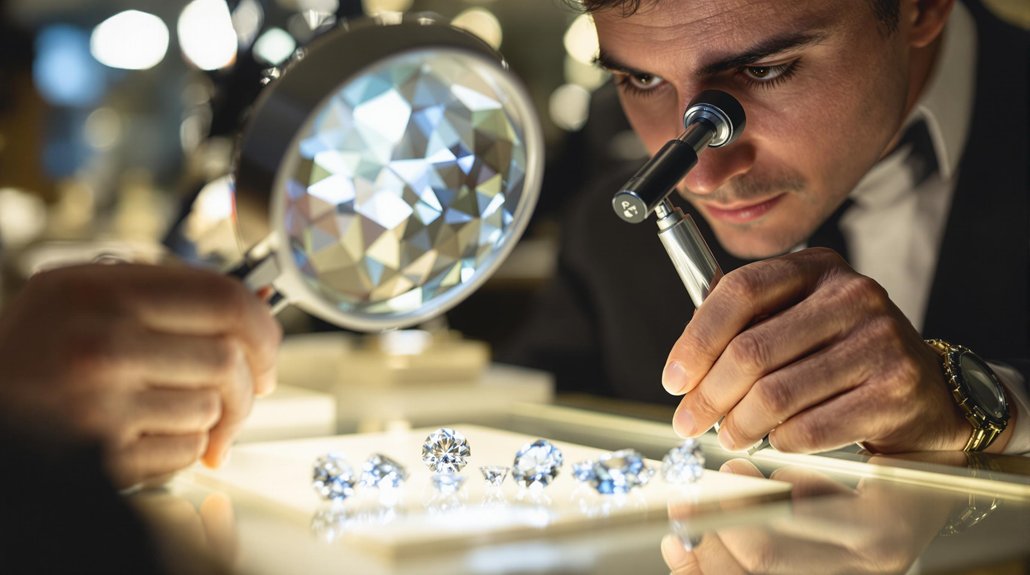Article Contents
- 1 Main Highlights
- 2 Making Hasty Diamond Purchase Decisions
- 3 Overlooking Diamond Certification Standards
- 4 Focusing Too Much on Carat Weight
- 5 Shopping Without Physical Examination
- 6 Falling for Deceptive Pricing Schemes
- 7 Selecting Uncertified Diamond Dealers
- 8 Ignoring After-Purchase Services and Policies
- 9 Our Final Thoughts
Like traversing a maze in the dark, purchasing a diamond without proper knowledge can lead you down costly dead ends. You'll face decisions about certification, cut quality, and pricing that could either save or cost you thousands of pounds. Whether you're planning to buy an engagement ring or invest in loose stones, comprehending these seven essential mistakes will protect your investment and guarantee you get the best value for your budget. Let's investigate how smart buyers avoid these expensive traps.
Main Highlights
- Making hasty purchase decisions without proper research of the 4 Cs leads to costly mistakes and buyer's remorse.
- Buying uncertified diamonds or trusting non-GIA certifications can result in significant value loss during resale.
- Focusing solely on carat weight whilst ignoring cut quality and other factors leads to overpaying for visually inferior diamonds.
- Purchasing diamonds online without physical inspection risks missing crucial flaws hidden by enhanced product images.
- Neglecting after-purchase services and proper insurance cover exposes buyers to unexpected maintenance costs and inadequate protection.
Making Hasty Diamond Purchase Decisions
Why do so many diamond buyers rush into purchases they later regret? Under time pressure, your brain enters a "special mode" that increases the likelihood of errors – especially when making high-stakes decisions like buying diamonds.
Hasty decisions and emotional buying often lead to costly mistakes that could have been avoided with proper planning. Research shows that younger, less experienced buyers are particularly vulnerable to making impulsive diamond purchases. Understanding that the GIA report may contain errors makes thorough evaluation crucial before purchasing. When choosing diamonds, understanding the 4 Cs is essential for making informed quality assessments. Careful consideration of potential consequences helps prevent buyer's remorse. Working with reputable jewellers ensures authenticity and quality in your diamond purchase.
Rushing to buy diamonds without proper research hits inexperienced shoppers hardest, turning exciting purchases into expensive regrets.
You'll want to resist the urge to rush, since about 80% of seemingly urgent situations resolve themselves with time.
To protect yourself, keep in mind that short-term "bargains" frequently result in long-term regrets.
Take a measured approach by:
- Researching thoroughly before visiting jewellers
- Setting a realistic timeframe for your purchase
- Getting multiple opinions on your selection
Overlooking Diamond Certification Standards

Visual assessment tools from online retailers like James Allen help avoid costly buying mistakes. The Kimberley Process ensures diamonds are ethically sourced and conflict-free. Whilst non-GIA certified diamonds might seem cheaper upfront, they lack the reliable quality verification you need to make an informed purchase. The new SCS-007 standard now provides additional sustainability and origin traceability assurance for both natural and laboratory-grown diamonds. Understanding the Four Cs grading helps ensure your diamond meets strict certification standards.
GIA Vs Other Labs
When evaluating diamond certifications, the GIA (Gemological Institute of America) stands apart from other labs due to its rigorous quality control and unmatched credibility.
You'll find that GIA's advantages include requiring at least four expert graders per diamond, whereas other labs often rely on just one or two evaluators. This difference in grading reliability is significant for your investment.
GIA's strict standards lead to more accurate valuations, with detailed inclusion maps and advanced microscopy that many other labs don't provide. The certification process typically requires about one month to complete.
When you're spending thousands on a diamond, this matters – 67% of non-GIA certified diamonds face value drops during resale.
The 4Cs grading system implemented by GIA represents the global standard for evaluating diamond quality and value.
Working with reputable jewellers ensures you receive genuine GIA-certified diamonds that maintain their value over time.
You'll similarly benefit from GIA's laser inscription registry and computer-assisted analysis, guaranteeing you're getting exactly what you pay for. Since its establishment in 1931, GIA has maintained its position as the world's leading authority in gemmology.
Hidden Quality Issues
Even the most thorough diamond certification can miss crucial quality issues that impact your investment. When evaluating a diamond's quality assurance, you'll need to look beyond the paperwork to protect yourself.
Both laboratory-grown diamonds and mined stones require careful quality verification despite their differing formation processes.
Common grading inconsistencies occur across several key areas:
- Colour grades can vary between laboratories, with some being more lenient than GIA
- Clarity ratings may not accurately reflect a stone's eye-clean status
- Cut proportions often represent averages rather than exact measurements
- Fluorescence details might be omitted or understated
- Treatment processes like HPHT may go undisclosed
Working with leading vendors like Brian Gavin Diamonds can help ensure more reliable certification standards and quality. To safeguard your purchase, always insist on a physical inspection alongside the certificate.
Flawless diamonds represent less than one per cent of all diamonds, making verification of high clarity claims particularly important.
Laboratories like EGL are known for upgrading diamonds significantly, which can mislead buyers about true quality.
Don't rely solely on documentation – verify the diamond's characteristics in person under different lighting conditions.
Focusing Too Much on Carat Weight
Many diamond shoppers become fixated on carat weight whilst overlooking other crucial factors that determine a stone's beauty and value.
The Four C grading system helps evaluate diamonds beyond just weight considerations.
Don't let perceived size blind you to the more important aspects of diamond quality.
A well-cut diamond sparkles brilliantly regardless of its weight class, making it a smarter investment than a larger but poorly cut stone.
Professional diamond grading ensures you understand the true quality beyond just size measurements.
Here's what you need to know: A one-carat diamond isn't necessarily larger or more valuable than a slightly smaller stone. Different cuts and shapes can make diamonds appear larger or smaller despite having the same weight.
For example, a 0.85-carat round brilliant diamond that's well-cut might look more impressive than a poorly-cut one-carat stone.
You'll likewise want to be careful about price jumps at popular carat weights. The cost difference between a 0.98-carat and 1-carat diamond can be substantial, yet they'll look nearly identical to the naked eye. Fancy shapes like marquise and oval can provide more visual spread whilst maintaining the same carat weight as round cuts.
Shopping Without Physical Examination

The biggest danger of buying diamonds sight-unseen comes from missing crucial flaws that photos cannot reveal. When you're shopping online, improved images and 360-degree videos can hide serious clarity issues or conceal treatments like laser drilling that affect a stone's value. Self-certified stones from retailers often lack independent verification standards.
To protect yourself when purchasing without physical inspection, you'll need more than a retailer's word on diamond authenticity. Only trust certificates from independent labs like GIA or AGS, and always verify them through the lab's official database. Retailer-issued certificates aren't reliable proof of authenticity. If a seller insists on wire transfer payments, consider this a warning sign and look elsewhere.
Remember that synthetic or treated stones are increasingly sophisticated, making them nearly impossible to detect through digital evaluation alone. Your safest approach is to work with jewellers who allow in-person viewing before purchase or offer full refund policies.
Falling for Deceptive Pricing Schemes

You'll encounter retailers using misleading "wholesale" price tags that mask huge markups, often doubling or tripling the true market value.
Watch for warning signs like pressure to buy straightaway, reluctance to provide detailed pricing breakdowns, or claims of "exclusive" deals that seem too good to be true.
These deceptive practices emerged after De Beers' market control weakened in the 1990s, leading to more volatile and opportunistic pricing strategies.
To protect yourself, always compare prices across multiple trusted vendors and research current market rates through independent sources like Rapaport or PriceScope before making a purchase. Consider exploring laboratory-grown diamond options that offer identical quality at 10-40% lower prices.
Fake "Wholesale" Price Tags
Spotting genuine wholesale diamond prices requires careful scrutiny in today's market. You'll encounter fake pricing schemes that claim to offer wholesale rates whilst actually selling lab-grown stones at inflated margins. Don't fall for wholesale deception tactics that misrepresent synthetic diamonds as natural ones. Retailers must maintain ethical standards when disclosing synthetic stones to protect consumer trust.
| Price Level | Natural Diamond | Lab-Grown Diamond |
|---|---|---|
| Retail | £1,535/ct | £90/ct |
| Wholesale | £1,100/ct | £75/ct |
| Production | £800/ct | £300/ct |
| Raw Material | £600/ct | £50/ct |
| Market Value | Appreciates | Depreciates |
Be especially wary of deals that seem too good to be true, particularly on sites like Alibaba where synthetic stones often carry counterfeit certificates. Recent criminal cases have shown that some dealers use forged GIA report numbers to pass off lab-grown diamonds as natural ones. Keep in mind authentic wholesale prices for natural diamonds typically reflect their billion-year formation process and genuine scarcity.
Hidden Markup Warning Signs
Even though diamond retailers often advertise incredible deals, hidden markup tactics can quickly inflate your final price beyond expectations.
Watch for retailers who layer multiple fees without clear pricing transparency, including percentage markups combined with administrative charges that can add hundreds to your total. Some sellers can apply up to 5 rules simultaneously to maximise their markup on diamond prices. Taking serious time to research prices is essential before making this significant purchase.
To protect yourself, be alert to these warning signs:
- Undisclosed markup percentages that exceed industry standards
- "Access code" requirements that mask true wholesale costs
- Hidden administrative fees tacked onto the final price
- Pre-printed appraisals with inflated replacement values
- Vague references to "speciality cuts" used to justify higher prices
Don't let pressure tactics rush your decision.
Request a complete breakdown of all fees and markups in writing before making your purchase.
Compare True Market Rates
Comprehending true diamond market rates requires careful attention to pricing patterns that many retailers deliberately obscure. To protect yourself from overpaying, understand how market price fluctuations and diamond demand trends affect costs at different carat weights. Laboratory grown alternatives cost approximately 67% less than natural diamonds. The Rappaport List price serves as the industry benchmark for determining diamond values each week.
| Weight (ct) | Premium Above Market | Price Jump | Risk Level |
|---|---|---|---|
| 0.99 | 0% | None | Low |
| 1.00 | 50% | Major | High |
| 1.99 | 75% | Severe | High |
| 2.00 | 200% | Extreme | Very High |
You'll save significantly by selecting diamonds just under these psychological price tiers. For example, choosing a 0.99-carat stone instead of 1.00 carats can save you 50% per carat whilst appearing virtually identical in size. Always verify certifications through GIA to confirm you're comparing true grades and values.
Selecting Uncertified Diamond Dealers
When you're evaluating uncertified diamond dealers, careful research becomes your best defence against potential fraud and misrepresentation.
Look for dealers who demonstrate transparency by providing detailed documentation and clear grading standards. Check their industry affiliations and partnership with recognised labs like GIA or IGI. Working with dealers who have established reputations will help ensure greater trust in transactions.
Verify the dealer's appraiser qualifications and track record through customer reviews and community feedback. The absence of third-party evaluation makes it essential to thoroughly vet any dealer's expertise. Don't rely solely on their word – request written guarantees and thorough return policies.
Compare their prices against certified diamond databases to confirm you're not overpaying.
Keep in mind that during uncertified stones may cost 20-25% less upfront, you'll face greater insurance hurdles and reduced resale value.
Consider these long-term implications when deciding whether the initial savings justify the increased risk.
Ignoring After-Purchase Services and Policies
Many diamond buyers focus solely on the purchase price whilst overlooking crucial after-purchase services and policies that protect their investment. Don't make this mistake, as service plan limitations can leave you exposed to unexpected costs. Similar to how AR-15 barrels require quality indicators for informed decisions, diamond purchases need careful evaluation of protection plans.
When evaluating insurance trade-offs, consider that standard service plans mainly cover basic maintenance like cleaning and repairs, typically for just 3 years. They won't protect you against loss or damage. Retailers that advertise continuous sales programmes often use inflated markups to create perceived discounts. Instead, look into specialised jewellery insurance through companies like Jewelers Mutual, which costs about £75 annually and provides thorough coverage.
Be wary of trade-up programmes that require spending at least double your original purchase price. These programmes often limit your flexibility and can lead to overpaying.
For better protection, combine a reliable certification (GIA/IGI) with independent insurance coverage.
Our Final Thoughts
You're about to make one of life's most precious investments, so don't let your diamond dreams become a financial nightmare. By avoiding these seven vital mistakes, you'll shine as bright as the jewel you're pursuing. Remember to take your time, verify certifications, and work with trusted dealers. Like a master jeweller examining every facet, approach your purchase with patience, knowledge, and confidence to secure the perfect diamond.

